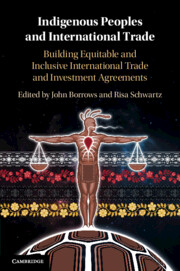 Indigenous Peoples and International Trade
Indigenous Peoples and International Trade from Part II - Building a More Equitable and Inclusive Free Trade Agreement
Published online by Cambridge University Press: 11 June 2020
In Chapter 8, Brenda Gunn looks to Canada as an example when she provides an analysis of how states have obligations to ensure the protection and promotion of Indigenous peoples’ rights in international investment agreements. Professor Gunn’s chapter begins by discussing some of the rights of Indigenous peoples that are potentially threatened by investment agreements, with a focus on land rights and the right to participate in decision-making on the basis of free, prior and informed consent. She concludes with a discussion of what measures need to be taken in investment agreements to ensure that Indigenous peoples’ rights are properly protected during the negotiation and implementation of investment agreements. This includes reference to the obligations of states and business enterprises to ensure that investment agreements protect Indigenous peoples’ rights while at the same time promoting foreign direct investment.
To save this book to your Kindle, first ensure no-reply@cambridge.org is added to your Approved Personal Document E-mail List under your Personal Document Settings on the Manage Your Content and Devices page of your Amazon account. Then enter the ‘name’ part of your Kindle email address below. Find out more about saving to your Kindle.
Note you can select to save to either the @free.kindle.com or @kindle.com variations. ‘@free.kindle.com’ emails are free but can only be saved to your device when it is connected to wi-fi. ‘@kindle.com’ emails can be delivered even when you are not connected to wi-fi, but note that service fees apply.
Find out more about the Kindle Personal Document Service.
To save content items to your account, please confirm that you agree to abide by our usage policies. If this is the first time you use this feature, you will be asked to authorise Cambridge Core to connect with your account. Find out more about saving content to Dropbox.
To save content items to your account, please confirm that you agree to abide by our usage policies. If this is the first time you use this feature, you will be asked to authorise Cambridge Core to connect with your account. Find out more about saving content to Google Drive.